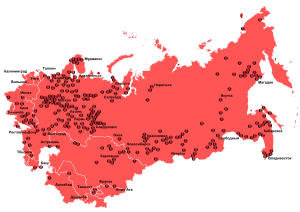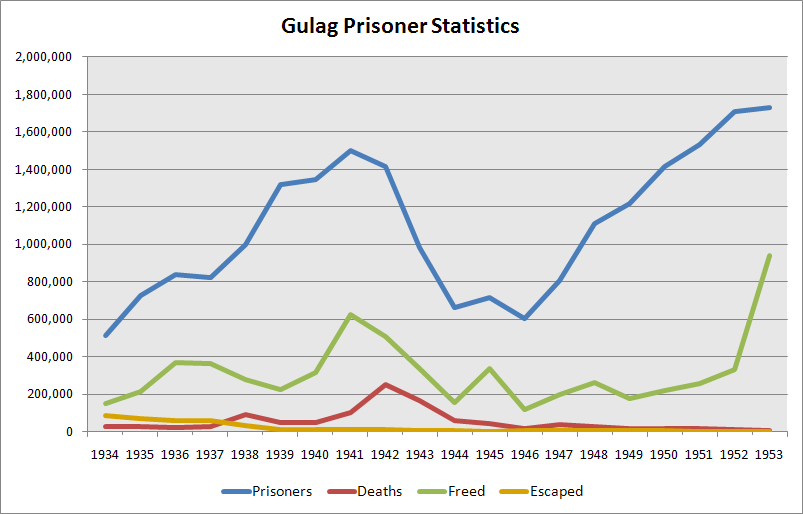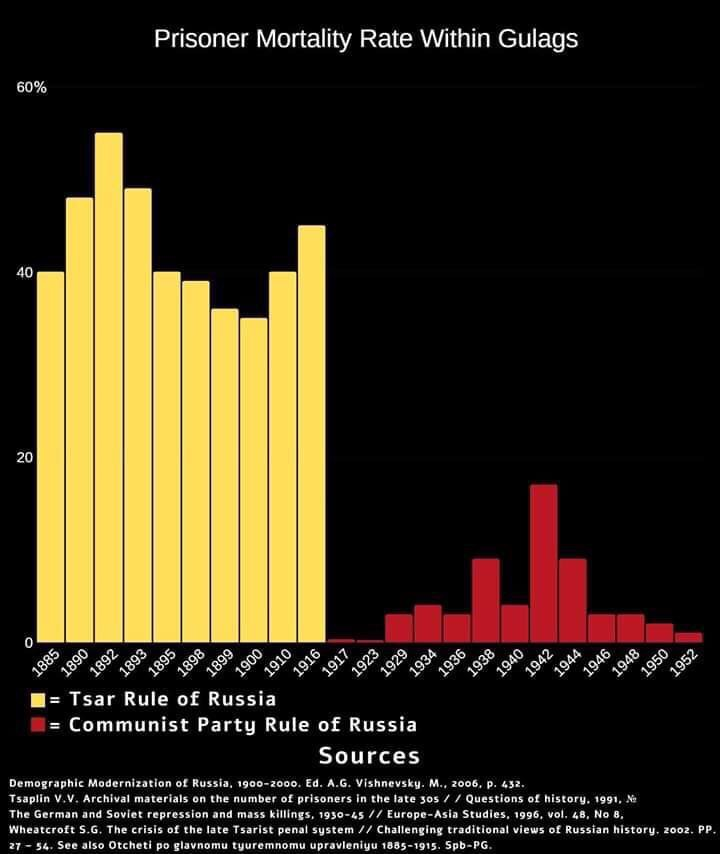Main Administration of Camps: Difference between revisions
(developed the article a lot) Tag: Visual edit |
(Added graph) Tag: Visual edit |
||
| Line 1: | Line 1: | ||
[[File:Gulag Location Map.svg|thumb|Map of all gulag prisons in the USSR. They were not all opened at the same time. Notably, it appears most were opened around Moscow.]] | [[File:Gulag Location Map.svg|thumb|Map of all gulag prisons in the USSR. They were not all opened at the same time. Notably, it appears most were opened around Moscow.]] | ||
The '''Main Administration of Camps''',<ref group="lower-alpha">Russian: Главное управление лагерей</ref> abbreviated as '''GULag''', was the system of prisons, camps, psychiatric hospitals, and special laboratories that housed prisoners in the [[Union of Soviet Socialist Republics (1922–1991)|Soviet Union]]. After the opening of the USSR archives, it was confirmed most of the prisoners were convicted of regular crimes and were not [[Counterrevolution|counterrevolutionaries]]. At the peak of the GULag system, shortly after the [[Second World War | The '''Main Administration of Camps''',<ref group="lower-alpha">Russian: Главное управление лагерей</ref> abbreviated as '''GULag''', was the system of prisons, camps, psychiatric hospitals, and special laboratories that housed prisoners in the [[Union of Soviet Socialist Republics (1922–1991)|Soviet Union]]. After the opening of the USSR archives, it was confirmed most of the prisoners were convicted of regular crimes and were not [[Counterrevolution|counterrevolutionaries]]. At the peak of the GULag system, shortly after the [[Second World War]] in 1951, 2.4% of the adult Soviet population was incarcerated, which represented 2.5 million prisoners. | ||
For comparison, 2.8% of the [[United States of America|United States]] population is currently incarcerated, which represents about 1.2 million prisoners.<ref name=":0">{{Web citation|author=Saed Teymuri|newspaper=The Stalinist Katyusha|title=The Truth about the Soviet Gulag - Surprisingly Revealed by the CIA|date=2018-10-31|url=https://stalinistkatyusha.wixsite.com/stalinist-katyusha/single-post/2018/10/04/The-Truth-about-the-Soviet-Gulag---Surprisingly-Revealed-by-the-CIA|archive-url=https://web.archive.org/web/20190401100827/https://stalinistkatyusha.wixsite.com/stalinist-katyusha/single-post/2018/10/04/The-Truth-about-the-Soviet-Gulag---Surprisingly-Revealed-by-the-CIA|archive-date=2019-04-01|retrieved=2022-09-11}}</ref> | For comparison, 2.8% of the [[United States of America|United States]] population is currently incarcerated, which represents about 1.2 million prisoners.<ref name=":0">{{Web citation|author=Saed Teymuri|newspaper=The Stalinist Katyusha|title=The Truth about the Soviet Gulag - Surprisingly Revealed by the CIA|date=2018-10-31|url=https://stalinistkatyusha.wixsite.com/stalinist-katyusha/single-post/2018/10/04/The-Truth-about-the-Soviet-Gulag---Surprisingly-Revealed-by-the-CIA|archive-url=https://web.archive.org/web/20190401100827/https://stalinistkatyusha.wixsite.com/stalinist-katyusha/single-post/2018/10/04/The-Truth-about-the-Soviet-Gulag---Surprisingly-Revealed-by-the-CIA|archive-date=2019-04-01|retrieved=2022-09-11}}</ref> | ||
| Line 9: | Line 9: | ||
== History == | == History == | ||
=== Second | === Second World War period === | ||
During the Second world war, the gulag population peaked, as did its mortality rate. As the whole country was focused on a [[war economy]] and fighting a devastating invasion from [[German Reich (1933–1945)|Nazi Germany]], sacrifices had to be made and many in the gulags felt it harshly (as did civilian populations on the frontlines that could not be evacuated in time). | During the Second world war, the gulag population peaked, as did its mortality rate. As the whole country was focused on a [[war economy]] and fighting a devastating invasion from [[German Reich (1933–1945)|Nazi Germany]], sacrifices had to be made and many in the gulags felt it harshly (as did civilian populations on the frontlines that could not be evacuated in time). | ||
| Line 18: | Line 18: | ||
=== Working conditions === | === Working conditions === | ||
Inmates worked 10-hour days until 1954, when the work day was reduced to 8 hours. After 1954, Prisoners who worked very productively could have their sentences reduced by up to half and were given extra food or money.<ref name=":0" /> The death rate in the gulags was highest during the [[Second World War]], but was always lower than the death rate in the [[Russian Empire (1721–1917)|Tsarist]] prison camps that had existed before the [[Russian revolution of 1917|revolution]], which had a death rate of over | [[File:Gulag death rate.png|thumb|Death rate in Russian/Soviet prison camps from 1885 to 1952. The highest death rate in the Soviet gulags was around 18% compared to a minimum of over 35% in the Russian Empire.]] | ||
Inmates worked 10-hour days until 1954, when the work day was reduced to 8 hours. After 1954, Prisoners who worked very productively could have their sentences reduced by up to half and were given extra food or money.<ref name=":0" /> The death rate in the gulags was highest during the [[Second World War]], but was always lower than the death rate in the [[Russian Empire (1721–1917)|Tsarist]] prison camps that had existed before the [[Russian revolution of 1917|revolution]], which had a death rate of over 40%.<ref>{{Citation|author=Anatoly Vishnevsky|year=2006|title=The Demographic Modernization of Russia, 1900-2000|title-url=https://www.panrus.com/books/details.php?bookID=11971|page=432|city=Moscow|isbn=5983790420}}</ref> | |||
== In popular fiction == | == In popular fiction == | ||
[[Aleksandr Solzhenitsyn]], a counter-revolutionary anti-Semite [[Pogrom|pogromist]], spent some time in Gulags. After his release, he fled the USSR and wrote a fictional tale called ''The gulag archipelago'' to garner support and funding abroad. Notably, his wife Natalya said that:<blockquote>The subject of ''Gulag Archipelago'', as I felt at the moment when he was writing it, is not in fact the life of the country and not even the life of the camps but the folklore of the camps<ref name=":1">{{Web citation|newspaper=New York Times|title=Solzhenitsyn's Ex‐Wife Says ‘Gulag’ Is ‘Folklore’|date=1974-02-06|url=https://www.nytimes.com/1974/02/06/archives/solzhenitsyns-exwife-says-gulag-is-folklore.html}}</ref></blockquote>She also claimed that she typed part of the book for Aleksandr when they were still living together.<ref name=":1" /> | [[Aleksandr Solzhenitsyn]], a counter-revolutionary [[Antisemitism|anti-Semite]] [[Pogrom|pogromist]], spent some time in Gulags. After his release, he fled the USSR and wrote a fictional tale called ''The gulag archipelago'' to garner support and funding abroad. Notably, his wife Natalya said that:<blockquote>The subject of ''Gulag Archipelago'', as I felt at the moment when he was writing it, is not in fact the life of the country and not even the life of the camps but the folklore of the camps<ref name=":1">{{Web citation|newspaper=New York Times|title=Solzhenitsyn's Ex‐Wife Says ‘Gulag’ Is ‘Folklore’|date=1974-02-06|url=https://www.nytimes.com/1974/02/06/archives/solzhenitsyns-exwife-says-gulag-is-folklore.html}}</ref></blockquote>She also claimed that she typed part of the book for Aleksandr when they were still living together.<ref name=":1" /> | ||
== Notes == | == Notes == | ||
<references group="lower-alpha" /> | <references group="lower-alpha" /> | ||
== References == | == References == | ||
Revision as of 13:56, 5 November 2022

The Main Administration of Camps,[a] abbreviated as GULag, was the system of prisons, camps, psychiatric hospitals, and special laboratories that housed prisoners in the Soviet Union. After the opening of the USSR archives, it was confirmed most of the prisoners were convicted of regular crimes and were not counterrevolutionaries. At the peak of the GULag system, shortly after the Second World War in 1951, 2.4% of the adult Soviet population was incarcerated, which represented 2.5 million prisoners.
For comparison, 2.8% of the United States population is currently incarcerated, which represents about 1.2 million prisoners.[1]
Many gulags were mostly self-sufficient, especially the more remote ones. Most could be compared to small villages or towns, and the less accessible ones did not even need any enclosures such as fences or walls; inmates were free to move around the prison as they pleased. The belief in the USSR was that labour was rehabilitative, and thus putting inmates to work for their benefit as well as the benefit of the collective (the Volga canal for example) was believed to help people away from criminality.

History
Second World War period
During the Second world war, the gulag population peaked, as did its mortality rate. As the whole country was focused on a war economy and fighting a devastating invasion from Nazi Germany, sacrifices had to be made and many in the gulags felt it harshly (as did civilian populations on the frontlines that could not be evacuated in time).
Post-war period
In 1954, under his anti-Stalin campaign, Khrushchev released many gulag inmates under the guise of them being falsely convicted. After the opening of the USSR archives however, it was found most of those inmates were common criminals that were released back into the general population.
Conditions in the gulag
Working conditions

Inmates worked 10-hour days until 1954, when the work day was reduced to 8 hours. After 1954, Prisoners who worked very productively could have their sentences reduced by up to half and were given extra food or money.[1] The death rate in the gulags was highest during the Second World War, but was always lower than the death rate in the Tsarist prison camps that had existed before the revolution, which had a death rate of over 40%.[2]
In popular fiction
Aleksandr Solzhenitsyn, a counter-revolutionary anti-Semite pogromist, spent some time in Gulags. After his release, he fled the USSR and wrote a fictional tale called The gulag archipelago to garner support and funding abroad. Notably, his wife Natalya said that:
The subject of Gulag Archipelago, as I felt at the moment when he was writing it, is not in fact the life of the country and not even the life of the camps but the folklore of the camps[3]
She also claimed that she typed part of the book for Aleksandr when they were still living together.[3]
Notes
- ↑ Russian: Главное управление лагерей
References
- ↑ 1.0 1.1 Saed Teymuri (2018-10-31). "The Truth about the Soviet Gulag - Surprisingly Revealed by the CIA" The Stalinist Katyusha. Archived from the original on 2019-04-01. Retrieved 2022-09-11.
- ↑ Anatoly Vishnevsky (2006). The Demographic Modernization of Russia, 1900-2000 (p. 432). Moscow. ISBN 5983790420
- ↑ 3.0 3.1 "Solzhenitsyn's Ex‐Wife Says ‘Gulag’ Is ‘Folklore’" (1974-02-06). New York Times.